Preparation and Application of Immobilized Surfactant-Modified PANi-CNT/TiO2 under Visible-Light Irradiation
Abstract
:1. Introduction
2. Experimental Section
2.1. Reagents
2.2. Preparation of Immobilized SCPS, SGPS, HCPS, and HGPS Series Photocatalysts on a Glass Plate
2.3. The Photocatalytic Degradation Tests
3. Results and Discussion
3.1. Characterization of PANI-CNT/TiO2 Photocatalysts
3.2. The Morphology of PANi-CNT/TiO2 Photocatalysts
3.3. The Photodegradation of DEP by Sol-Gel-Synthesized PANi-CNT/TiO2 Photocatalysts
3.4. The Photodegradation of DEP by Hydrothermally-Synthesized PANi-CNT/TiO2 Photocatalysts
3.5. Characteristics and Photocatalytic Activity of PANi-CNT/TiO2 Photocatalysts
4. Conclusions
- Owing to PANi with the characteristics of absorbing visible light, the adsorption edge of surfactant- modified PANi-CNT/TiO2 photocatalysts shifted up to 442 nm when PANi addition was increased up to 5%. The most distinguished red-shift of the adsorption edge was found for the SGPS and HGPS series photocatalysts.
- The anionic surfactant, SDS, plays an important role in determining a link between the PANi polymers and the coating film up to 314–400 nm and 1301–1600 nm for so-gel hydrolysis and hydrothermally-synthesized photocatalysts, respectively. An appropriate coating film thickness would extend the transfer path of electrons and inhibit the recombination of electrons and electron-holes. Hence, the coating film thickness of immobilized photocatalysts may be considered for the evaluation of the photo-catalytic activity.
- The degradation of DEP by both sol-gel synthesized PANi-CNT/TiO2 photocatalysts and hydrothermally-synthesized PANi-CNT/TiO2 photocatalysts obeyed the pseudo first-order kinetic model. The photo-degradation of DEP by hydrothermally synthesized PANi-CNT/TiO2 photocatalysts under 410-nm irradiation was better than that by sol-gel hydrolysis PANi-CNT/TiO2 photocatalysts. This may be due to the lower fraction of PANi and CNT which was found in the sol-gel hydrolysis photocatalysts due to their high-temperature preparation.
- The results of the hydroxyl radical quantification revealed that the hydroxyl radicals were the key oxidant for the degradation DEP for the hydrothermally-synthesized PANi-CNT/TiO2 photocatalysts, but this was not true for the sol-gel hydrolysis photocatalysts. Further investigation is needed for the generation of any other radicals, such as superoxide radicals (O2−•), in the sol-gel hydrolysis photocatalysts’ system, in order to clarify the degradation mechanisms.
- For sol-gel-synthesized photocatalysts, both PANi and SDS were important to enhance the photo-catalytic acticity; whereas, for hydrotermally-synthesized photocatalysts, the contribution of SDS to photocatalytic activity was more critical. Their photocatalytic activities were stable for at least five cycles. The surface of the photocatalyst was covered with trace impurities when it was freshly prepared; hence, the photo-catalytic performance at the first cycle for all immobilized photocatalysts was not superior to those of the other subsequent uses.
Acknowledgments
Author Contributions
Conflicts of Interest
References
- Venkata Mohan, S.; Shailaja, S.; Rama Krishna, M.; Sarma, P.N. Adsorptive removal of phthalate ester (Di-ethyl phthalate) from aqueous phase by activated carbon: a kinetic study. J. Hazard. Mater. 2007, 146, 278–282. [Google Scholar] [CrossRef] [PubMed]
- Wu, M.H.; Liu, N.; Xu, G.; Ma, J.; Tang, L.; Wang, L.; Fu, H.Y. Kinetics and mechanisms studies on dimethyl phthalate degradation in aqueous solutions by pulse radiolysis and electron beam radiolysis. Radiat. Phys. Chem. 2011, 80, 420–425. [Google Scholar]
- Kaneco, S.; Rahman, M.A.; Suzuki, T.; Katsumata, H.; Ohta, K. Optimization of solar photocatalytic degradation conditions of bisphenol A in water using titanium dioxide. J. Photochem. Photobiol 2004, A 163, 419–424. [Google Scholar] [CrossRef]
- Jing, Y.; Li, L.S.; Zhang, Q.Y.; Lu, P.; Liu, P.H.; Lu, X.H. Photocatalytic ozonation of dimethyl phthalate with TiO2 prepared by a hydrothermal method. J. Hazard. Mater. 2011, 189, 40–47. [Google Scholar]
- Cinelli, G.; Avino, P.; Notardonato, I.; Centola, A.; Russo, M.V. Study of XAD-2 adsorbent for the enrichment of trace levels of phthalate esters in hydroalcoholic food beverages and analysis by gas chromatography coupled with flame ionization and ion-trap mass spectrometry detectors. Food Chem. 2014, 146, 181–187. [Google Scholar] [CrossRef] [PubMed]
- Barse, A.V.; Chakrabarti, T.; Ghosh, T.K.; Pal, A.K.; Jadhao, S.B. Endocrine disruption and metabolic changes following exposure of Cyprinus. carpio to diethyl phthalate. Pestic. Biochem. Physiol. 2007, 88, 36–42. [Google Scholar] [CrossRef]
- Na, S.; Jinhua, C.; Cui, M.; Khim, J. Sonophotolytic diethyl phthalate (DEP) degradation with UVC or VUV irradiation. Ultrason. Sonochem. 2012, 19, 1094–1098. [Google Scholar] [CrossRef] [PubMed]
- Roslev, P.; Vorkamp, K.; Aarup, J.; Frederiksen, K.; Nielsen, P.H. Degradation of phthalate esters in an activated sludge wastewater treatment plant. Water Res. 2007, 41, 969–976. [Google Scholar]
- Xu, Z.; Zhang, W.; Pan, B.; Hong, C.; Lv, L.; Zhang, Q.; Pan, B.; Zhang, Q. Application of the Polanyi potential theory to phthalates adsorption from aqueous solution with hyper-cross-linked polymer resins. J. Colloid Interface Sci. 2008, 319, 392–397. [Google Scholar] [CrossRef] [PubMed]
- Vimonses, V.; Jin, B.; Chow, C.W.K.; Saint, C. An adsorption–photocatalysis hybrid process using multi-functional-nanoporous materials for wastewater reclamation. Water Res. 2010, 44, 5385–5397. [Google Scholar] [CrossRef] [PubMed]
- Liu, L.; Bai, H.; Liu, J.; Sun, D.D. Multifunctional graphene oxide-TiO2-Ag nanocomposites for high performance water disinfection and decontamination under solar irradiation. J. Hazard. Mater. 2013, 261, 214–223. [Google Scholar] [CrossRef] [PubMed]
- Oros-Ruiz, S.; Zanella, R.; Prado, B. Photocatalytic degradation of trimethoprim by metallic nanoparticles supported on TiO2-P25. J. Hazard. Mater. 2013, 263, 28–35. [Google Scholar] [CrossRef] [PubMed]
- Asiltürk, M.; Şener, Ş. TiO2-activated carbon photocatalysts: Preparation, characterization and photocatalytic activities. Chem. Eng. J. 2012, 180, 354–363. [Google Scholar] [CrossRef]
- Singh, S.; Mahalingam, H.; Singh, P.K. Polymer-supported titanium dioxide photocatalysts for environmental remediation: A review. Appl. Catal., A-Gen. 2013, 462–463, 178–195. [Google Scholar] [CrossRef]
- Fang, J.; Xu, L.; Zhang, Z.; Yuan, Y.; Cao, S.; Wang, Z.; Yin, L.; Liao, Y.; Xue, C. Au@TiO2–CdS Ternary Nanostructures for Efficient Visible-Light-Driven Hydrogen Generation. ACS Appl. Mater. Interfaces 2013, 5, 8088–8092. [Google Scholar] [CrossRef] [PubMed]
- Zhao, Y.; Pan, F.; Li, H.; Zhao, D.; Liu, L.; Xu, G.Q.; Chen, W. Uniform mesoporous anatase–brookite biphase TiO2 hollow spheres with high crystallinity via ostwald ripening. J. Phys. Chem. 2013, C 117, 21718–21723. [Google Scholar]
- Byrappa, K.; Dayananda, A.S.; Sajan, C.P.; Basavalingu, B.; Shayan, M.B.; Soga, K.; Yoshimura, M. Hydrothermal preparation of ZnO:CNT and TiO2:CNT composites and their photocatalytic applications. J. Mater. Sci. 2008, 43, 2348–2355. [Google Scholar] [CrossRef]
- Hung, C.H.; Yuan, C.; Li, H.W. Photodegradation of diethyl phthalate with PANi-CNT/TiO2 immobilized on glass plate irradiated with visible light and simulated sunlight—effect of synthesized method and pH. J. Hazard. Mater. 2017, 322, 243–253. [Google Scholar] [CrossRef] [PubMed]
- Hung, C.H.; Chuang, B.C.; Lien, H.L.; Yuan, C. Photocatalytic Degradation of Bisphenol A Using TiO2/CNTs Nanocomposites under UV Irradiation. In Interactions of Nanomaterials with Emerging Environmental Contaminants; Doong, R.A., Sharma Virender, K., Kim, H., Eds.; ACS: Washington, D.C., USA, 2013; pp. 121–134. [Google Scholar]
- Zhang, K.; Zhang, F.J.; Chen, M.L.; Oh, W.C. Comparison of catalytic activities for photocatalytic and sonocatalytic degradation of methylene blue in present of anatase TiO2–CNT catalysts. Ultrason. Sonochem. 2011, 18, 765–772. [Google Scholar] [CrossRef] [PubMed]
- Miranda, S.M.; Romanos, G.E.; Likodimos, V.; Marques, R.R.N.; Favvas, E.P.; Katsaros, F.K.; Stefanopoulos, K.L.; Vilar, V.J.P.; Faria, J.L.; Falaras, P.; Silva, A.M.T. Pore structure, interface properties and photocatalytic efficiency of hydration/dehydration derived TiO2/CNT composites. Appl. Catal. B Environ. 2014, 147, 65–81. [Google Scholar] [CrossRef]
- Silva, C.G.; Faria, J.L. Photocatalytic oxidation of benzene derivatives in aqueous suspensions: Synergic effect induced by the introduction of carbon nanotubes in a TiO2 matrix. Appl. Catal. B Environ. 2010, 101, 81–89. [Google Scholar] [CrossRef]
- Xu, Y.J.; Zhuang, Y.; Fu, X. New Insight for Enhanced Photocatalytic Activity of TiO2 by Doping Carbon Nanotubes: A Case Study on Degradation of Benzene and Methyl Orange. J. Phys. Chem. C 2010, 114, 2669–2676. [Google Scholar] [CrossRef]
- Reddy, K.R.; Sin, B.C.; Ryu, K.S.; Kim, J.C.; Chung, H.; Lee, Y. Conducting polymer functionalized multi-walled carbon nanotubes with noble metal nanoparticles: Synthesis, morphological characteristics and electrical properties. Synth. Met. 2009, 159, 595–603. [Google Scholar] [CrossRef]
- Reddy, K.R.; Nakata, K.; Ochiai, T.; Murakami, T.; Tryk, D.A.; Fujishima, A. Nanofibrous TiO2-Core/Conjugated Polymer-Sheath Composites: Synthesis, Structural Properties and Photocatalytic Activity. J. Nanosci. Nanotechnol. 2010, 10, 7951–7957. [Google Scholar] [CrossRef] [PubMed]
- Park, O.K.; Hahm, M.G.; Lee, S.; Joh, H.I.; Na, S.I.; Vajtai, R.; Lee, J.H.; Ku, B.C.; Ajayan, P.M. In situ synthesis of thermochemically reduced graphene oxide conducting nanocomposites. Nano. Lett. 2012, 12, 1789–1793. [Google Scholar] [CrossRef] [PubMed]
- Zhang, H.; Zong, R.; Zhu, Y. Photocorrosion Inhibition and Photoactivity Enhancement for Zinc Oxide via Hybridization with Monolayer Polyaniline. J. Phys. Chem. C. 2009, 113, 4605–4611. [Google Scholar] [CrossRef]
- Lin, C.J.; Liou, Y.H.; Zhang, Y.; Chen, C.L.; Dong, C.L.; Chen, S.Y.; Stucky, G.D. Mesoporous Fe-doped TiO2 sub-microspheres with enhanced photocatalytic activity under visible light illumination. Appl. Catal. B Environ. 2012, 127, 175–181. [Google Scholar] [CrossRef]
- Radoičić, M.; Šaponjić, Z.; Janković, I.A.; Ćirić-Marjanović, G.; Ahrenkiel, S.P.; Čomor, M.I. Improvements to the photocatalytic efficiency of polyaniline modified TiO2 nanoparticles. Appl. Catal. B Environ. 2013, 136–137, 133–139. [Google Scholar]
- Reddy, K.R.; Hassan, M.; Gomes, V.G. Hybrid nanostructures based on titanium dioxide for enhanced photocatalysis. Appl. Catal. A Gen. 2015, 489, 1–16. [Google Scholar] [CrossRef]
- Chen, K.; Li, J.; Wang, W.; Zhang, Y.; Wang, X.; Su, H. Effects of surfactants on microstructure and photocatalytic activity of TiO2 nanoparticles prepared by the hydrothermal method. Mater. Sci. Semicond. Process. 2012, 15, 20–26. [Google Scholar] [CrossRef]
- Yavuz, A.G.; Gok, A. Preparation of TiO2/PANi composites in the presence of surfactants and investigation of electrical properties. Synth. Met. 2007, 157, 235–242. [Google Scholar] [CrossRef]
- Lesch, A.; Cortés-Salazar, F.; Prudent, M.; Delobel, J.; Rastgar, S.; Lion, N.; Tissot, J.D.; Tacchini, P.; Girault, H.H. Large scale inkjet-printing of carbon nanotubes electrodes for antioxidant assays in blood bags. J. Electroanal. Chem. 2014, 717–718, 61–68. [Google Scholar] [CrossRef]
- Subramanian, M.; Vijayalakshmi, S.; Venkataraj, S.; Jayavel, R. Effect of cobalt doping on the structural and optical properties of TiO2 films prepared by sol–gel process. Thin Solid Films 2008, 516, 3776–3782. [Google Scholar] [CrossRef]
- Guo, W.; Liu, X.; Huo, P.; Gao, X.; Wu, D.; Lu, Z.; Yan, Y. Hydrothermal synthesis spherical TiO2 and its photo-degradation property on salicylic acid. Appl. Surf. Sci. 2012, 258, 6891–6896. [Google Scholar] [CrossRef]
- Dunlop, P.S.M.; McMurray, T.A.; Hamilton, J.W.J.; Byrne, J.A. Photocatalytic inactivation of Clostridium perfringens spores on TiO2 electrodes. J. Photochem. Photobiol. A 2008, 196, 113–119. [Google Scholar] [CrossRef]
- Raja, P.; Nadtochenko, V.; Klehm, U.; Kiwi, J. Structure and performance of a novel TiO2-phosphonate composite photocatalyst. Appl. Catal. B Environ. 2008, 81, 258–266. [Google Scholar] [CrossRef]
- Choi, K.I.; Lee, S.H.; Park, J.Y.; Choi, D.Y.; Hwang, C.H.; Lee, I.H.; Chang, M.H. Fabrication and characterization of hollow TiO2 fibers by microemulsion electrospinning for photocatalytic reactions. Mater. Lett. 2013, 112, 113–116. [Google Scholar] [CrossRef]
- Vaiano, V.; Sacco, O.; Sannino, D.; Ciambelli, P. Nanostructured N-doped TiO2 coated on glass spheres for the photocatalytic removal of organic dyes under UV or visible light irradiation. Appl. Catal. B Environ. 2015, 170–171, 153–161. [Google Scholar] [CrossRef]
- Jiménez, M.; Ignacio Maldonado, M.; Rodríguez, E.M.; Hernández-Ramírez, A.; Saggioro, E.; Carra, I.; Sánchez Pérez, J.A. Supported TiO2 solar photocatalysis at semi-pilot scale: degradation of pesticides found in citrus processing industry wastewater, reactivity and influence of photogenerated species. J. Chem. Technol. Biotechnol. 2015, 90, 149–157. [Google Scholar] [CrossRef]
- Shan, A.Y.; Ghazi, T.I.M.; Rashid, S.A. Immobilisation of titanium dioxide onto supporting materials in heterogeneous photocatalysis: A review. Appl. Catal. A Gen. 2010, 389, 1–8. [Google Scholar] [CrossRef]
- Abdel daiem, M.M.; Rivera-Utrilla, J.; Ocampo-Perez, R.; Mendez-Diaz, J.D.; Sanchez-Polo, M. Environmental impact of phthalic acid esters and their removal from water and sediments by different technologies--a review. J. Environ. Manag. 2012, 109, 164–178. [Google Scholar] [CrossRef] [PubMed]
- Wang, H.; Wang, H.L.; Jiang, W.F. Solar photocatalytic degradation of 2,6-dinitro-p-cresol (DNPC) using multi-walled carbon nanotubes (MWCNTs)–TiO2 composite photocatalysts. Chemosphere 2009, 75, 1105–1111. [Google Scholar] [CrossRef] [PubMed]
- Wu, K.R.; Hung, C.H. Characterization of N,C-codoped TiO2 films prepared by reactive DC magnetron sputtering. Appl. Surf. Sci. 2009, 256, 1595–1603. [Google Scholar] [CrossRef]
- Lindsey, M.E.; Tarr, M.A. Quantitation of hydroxyl radical during fenton oxidation following a single addition of iron and peroxide. Chemosphere 2000, 41, 409–417. [Google Scholar]
- Lee, Y.; Lee, C.; Yoon, J. Kinetics and mechanisms of DMSO (dimethylsulfoxide) degradation by UV/H2O2 process. Water Res. 2004, 38, 2579–2588. [Google Scholar] [CrossRef] [PubMed]
- Subramanian, E.; Subbulakshmi, S.; Murugan, C. Inter-relationship between nanostructures of conducting polyaniline and the photocatalytic methylene blue dye degradation efficiencies of its hybrid composites with anatase TiO2. Mater. Res. Bull. 2014, 51, 128–135. [Google Scholar] [CrossRef]
- Chang, C.F.; Man, C.Y. Titania-coated magnetic composites as photocatalysts for phthalate photodegradation. Ind. Eng. Chem. Res. 2011, 50, 11620–11627. [Google Scholar] [CrossRef]
- Inanaga, J.; Hirata, K.; Saeki, H.; Katsuki, T.; Yamaguchi, M. A Rapid Esterification by Means of Mixed Anhydride and Its Application to Large-ring Lactonization. Bull. Chem. Soc. Jpn. 1979, 52, 1989–1993. [Google Scholar] [CrossRef]
- Radoičić, M.; Ćirić-Marjanović, G.; Spasojević, V.; Ahrenkiel, P.; Mitrić, M.; Novaković, T.; Šaponjić, Z. Superior photocatalytic properties of carbonized PANI/TiO2 nanocomposites. Appl. Catal. B Environ. 2017, 213, 155–166. [Google Scholar]
- Massoumi, B.; Jaymand, M.; Samadi, R.; Entezami, A. In situ chemical oxidative graft polymerization of thiophene derivatives from multi-walled carbon nanotubes. J. Polym. Res. 2014, 21, 1–9. [Google Scholar] [CrossRef]
- Sahoo, N.G.; Cheng, H.K.F.; Li, L.; Chan, S.H.; Judeh, Z.; Zhao, J. Specific Functionalization of Carbon Nanotubes for Advanced Polymer Nanocomposites. Adv. Funct. Mater. 2009, 19, 3962–3971. [Google Scholar] [CrossRef]
- Oueiny, C.; Berlioz, S.; Perrin, F.X. Carbon nanotube–polyaniline composites. Prog. Polym. Sci. 2014, 39, 707–748. [Google Scholar] [CrossRef]
- Katoch, A.; Burkhart, M.; Hwang, T.; Kim, S.S. Synthesis of polyaniline/TiO2 hybrid nanoplates via a sot-gel chemical method. Chem. Eng. J. 2012, 192, 262–268. [Google Scholar] [CrossRef]
- Sriwong, C.; Wongnawa, S.; Patarapaiboolchai, O. Rubber sheet strewn with TiO2 particles: Photocatalytic activity and recyclability. J. Environ. Sci. 2012, 24, 464–472. [Google Scholar] [CrossRef]
- Li, X.; Wang, D.; Cheng, G.; Luo, Q.; An, J.; Wang, Y. Preparation of polyaniline-modified TiO2 nanoparticles and their photocatalytic activity under visible light illumination. Appl. Catal. B Environ. 2008, 81, 267–273. [Google Scholar] [CrossRef]
- Huang, X.; Wang, G.; Yang, M.; Guo, W.; Gao, H. Synthesis of polyaniline-modified Fe3O4/SiO2/TiO2 composite microspheres and their photocatalytic application. Mater. Lett. 2011, 65, 2887–2890. [Google Scholar] [CrossRef]
- Yang, K.; Pu, W.; Tan, Y.; Zhang, M.; Yang, C.; Zhang, J. Enhanced photoelectrocatalytic activity of Cr-doped TiO2 nanotubes modified with polyaniline. Mater. Sci. Semicond. Process. 2014, 27, 777–784. [Google Scholar] [CrossRef]
- Nourbakhsh, A.; Abbaspour, S.; Masood, M.; Mirsattari, S.N.; Vahedi, A.; Mackenzie, K.J.D. Photocatalytic properties of mesoporous TiO2 nanocomposites modified with carbon nanotubes and copper. Ceram. Int. 2016, 42, 11901–11906. [Google Scholar] [CrossRef]
- Zouzelka, R.; Kusumawati, Y.; Remzova, M.; Rathousky, J.; Pauporte, T. Photocatalytic activity of porous multiwalled carbon nanotube-TiO2 composite layers for pollutant degradation. J. Hazard. Mater. 2016, 317, 52–59. [Google Scholar] [CrossRef] [PubMed]
- Li, Y.; Yu, Y.; Wu, L.; Zhi, J. Processable polyaniline/titania nanocomposites with good photocatalytic and conductivity properties prepared via peroxo-titanium complex catalyzed emulsion polymerization approach. Appl. Surf. Sci. 2013, 273, 135–143. [Google Scholar] [CrossRef]
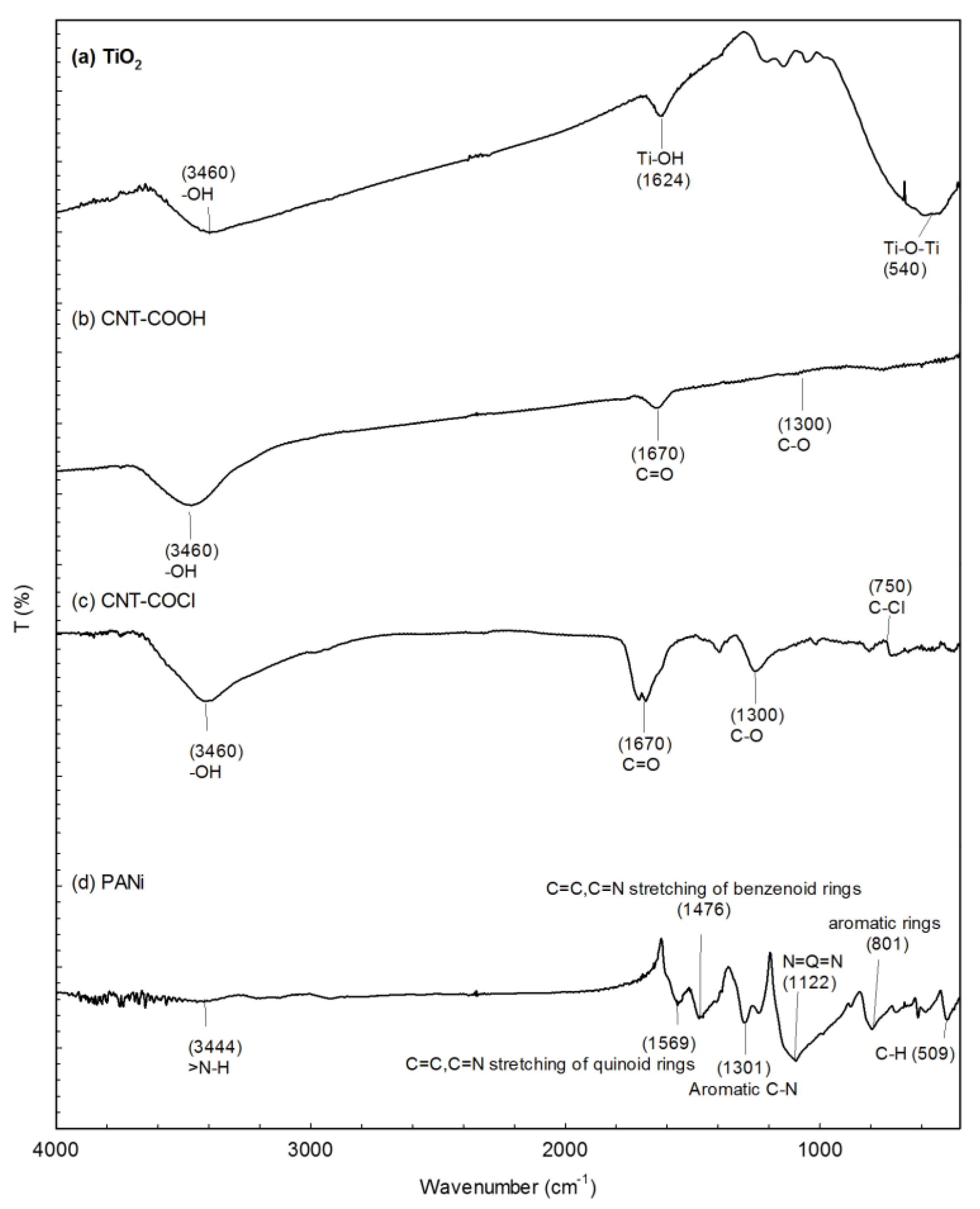
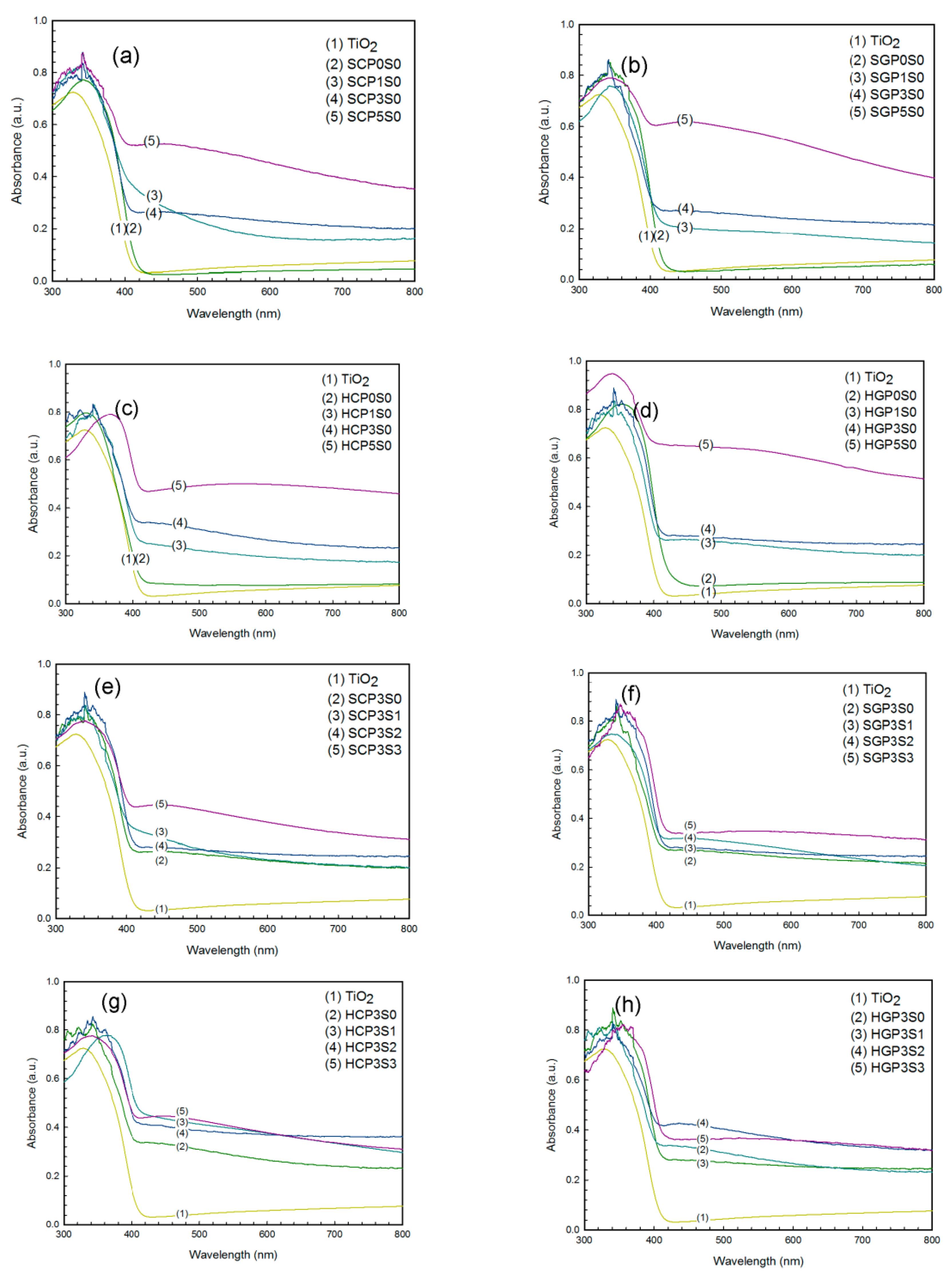
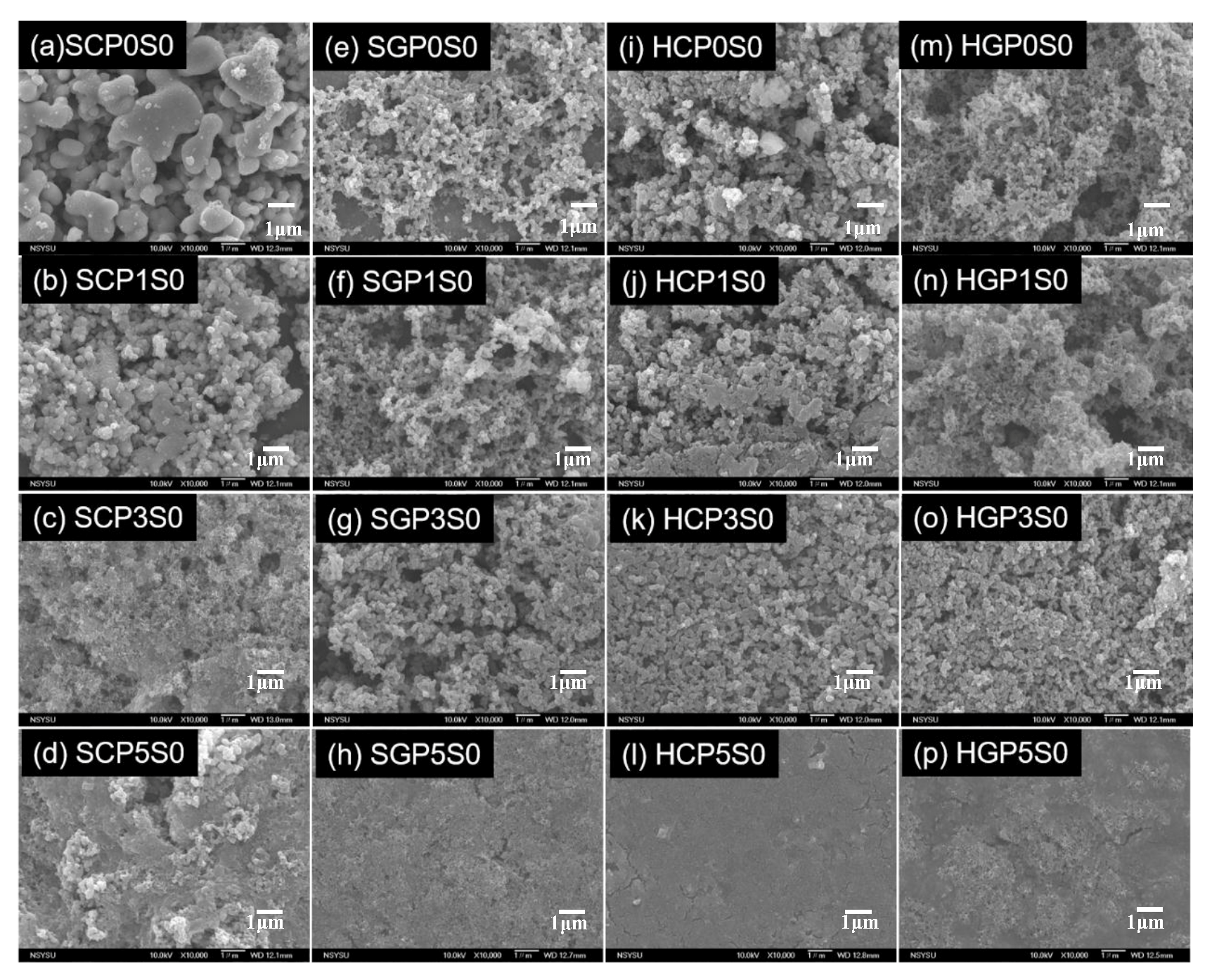
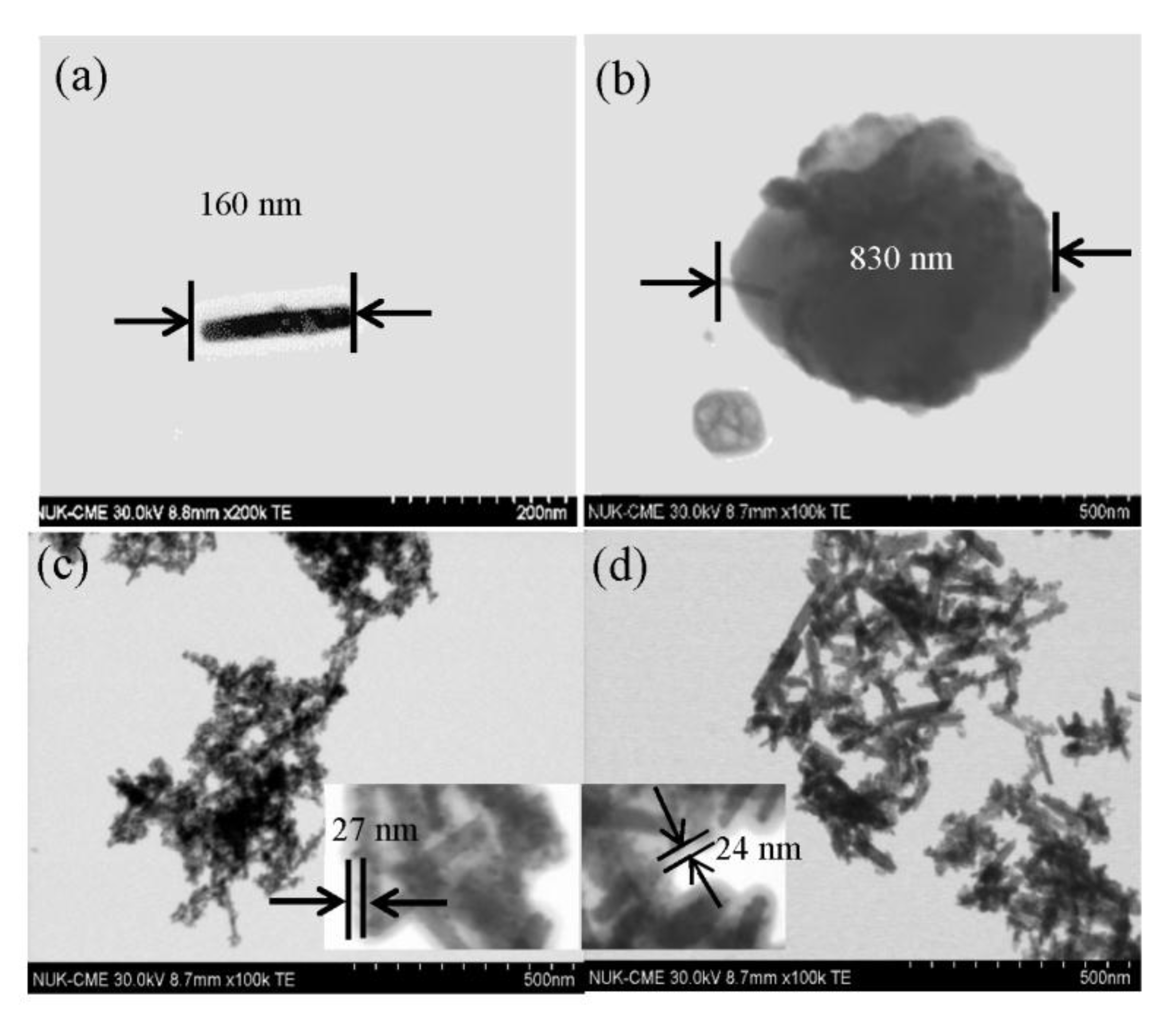
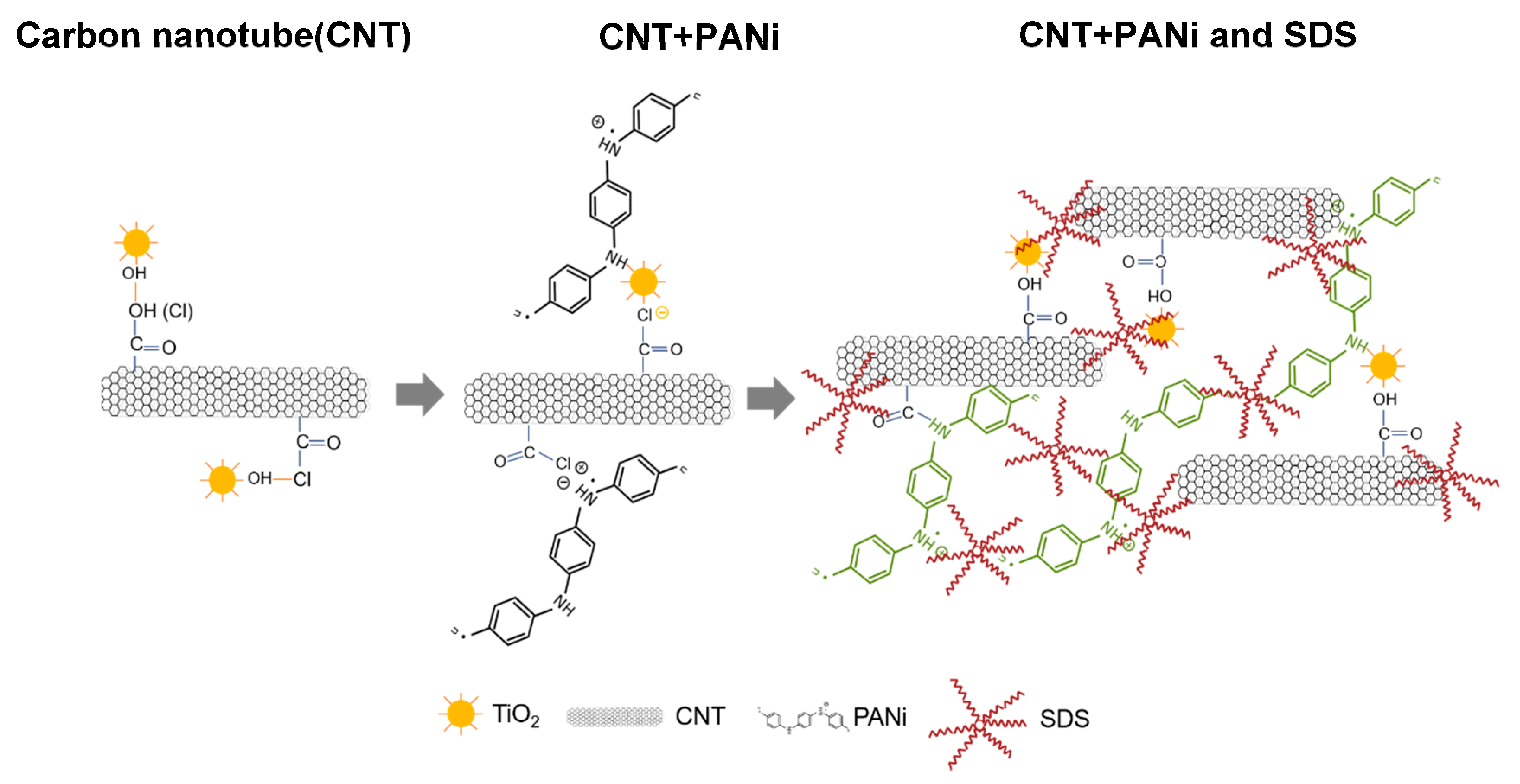
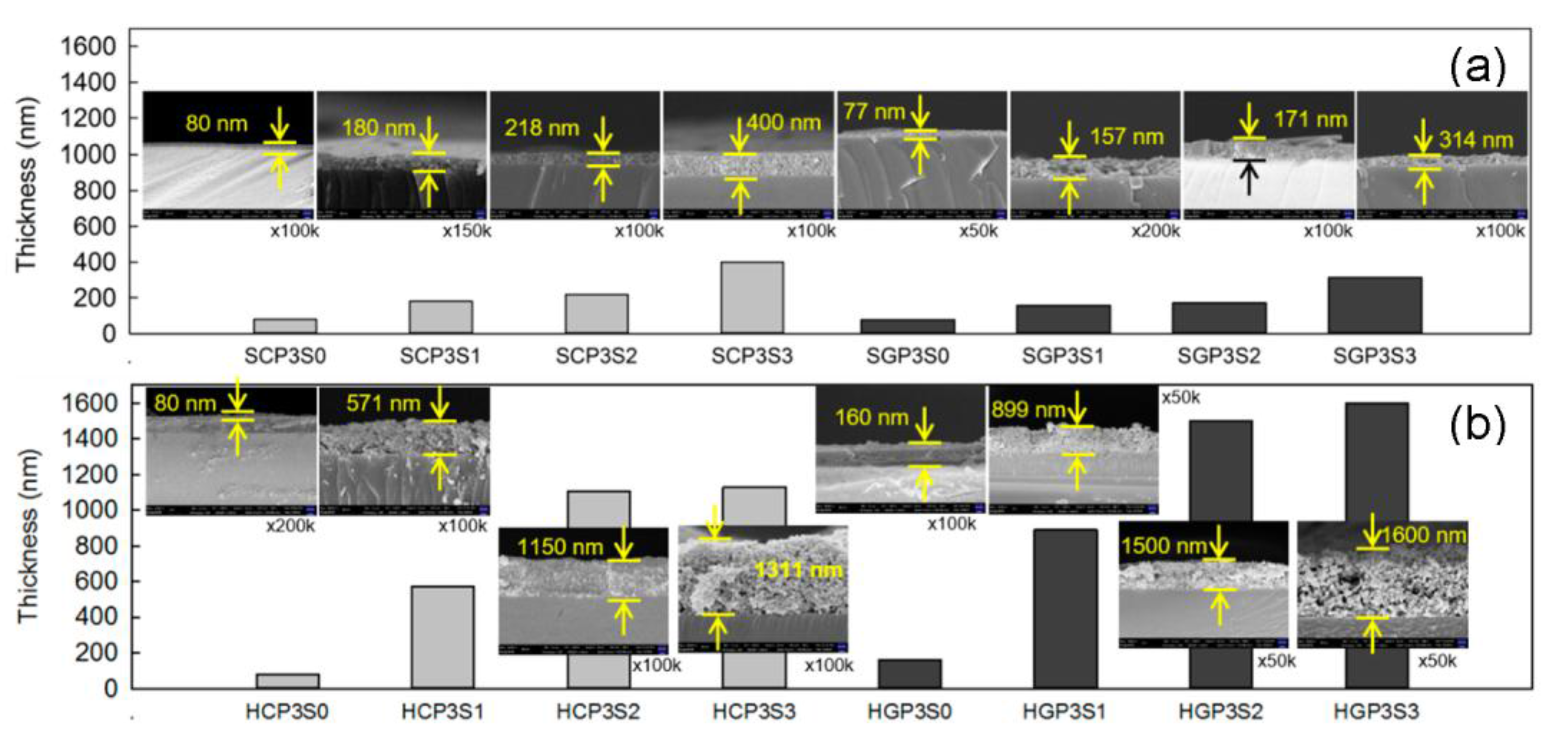

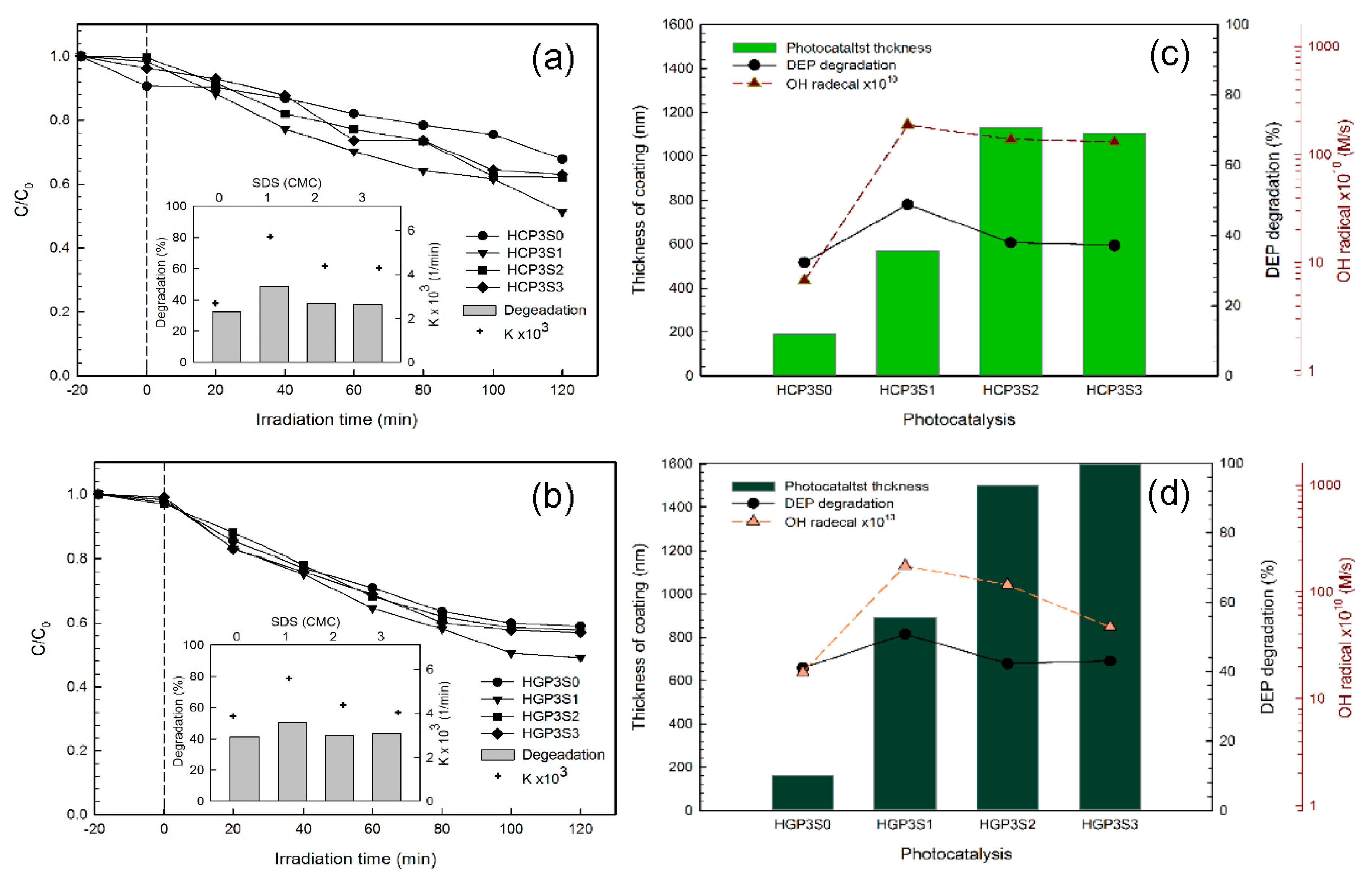
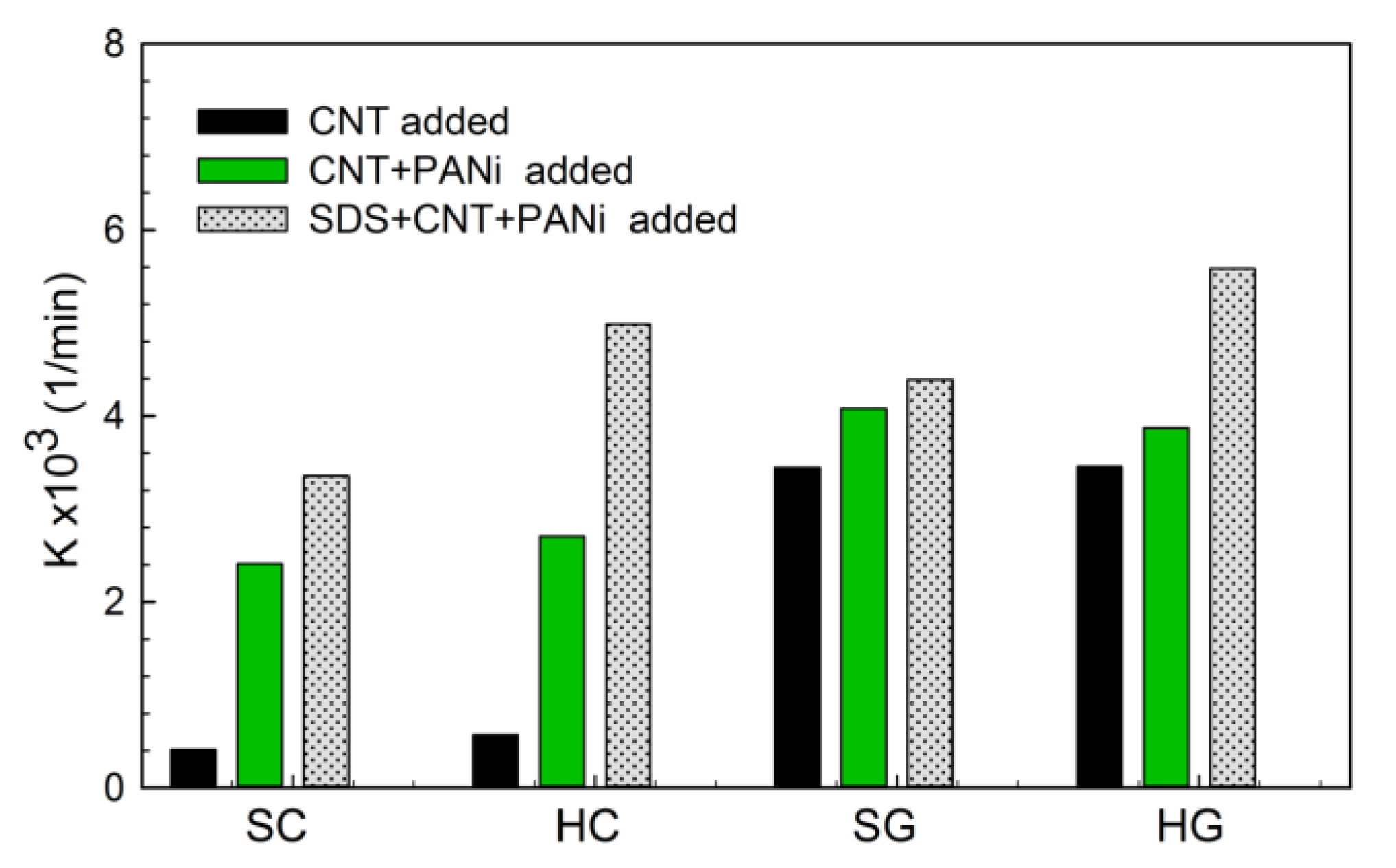

| References | TiO2 Source; Preparation Method; A/R * | Dopant | Polymer; Concentration | Surfactant | Light Source; Intensity/Power | Chemicals; Concentration | Reaction Rate Constant (1/min) |
|---|---|---|---|---|---|---|---|
| Li et al. [56] | tetrabutyl titanate ; sol-gel hydrolysis; 100/0 | - | PANi; 1.6–3.2 wt % | - | λ > 400 nm; 300 W | phenol; 50 mg/L | 2.7 10−3–3.1 10−3 |
| Huang et al. [57] | Fe3O4/SiO2/TiO2(TBT); sol–gel hydrolysis; 100/0 | Fe3O4/SiO2 | PANi; 2–4.2 wt % | - | 420 nm; not mentioned | Methyl blue; 10 mg/L | 9.5 10−4–1.3 10−3 |
| Radoičić et al. [29] | TiCl4; sol-gel hydrolysis; 100/0 | - | PANi; 0.5–1.5 wt % | - | UVB (280~315 nm); 3 W UVA (315~400 nm); 13.6W | Methyl blue; 10−5 M Rhodamine B; 10−5 M | 3.2 10−2–1.2 10−3; 9.4 10−4–5.4 10−3 |
| Yang et al. [58] | Ti foil; - ; not mentioned | Cr | PANi; not mentioned | - | Λ = 253.7 nm; 15 W | p-Nitrophenol; not mentioned | 6.310−3–10.310−3 |
| Nourbakhsh et al. [59] | TTIP; sol-gel hydrolysis; 50/50 | Cu: 2–13%, CNT: 11% | - | - | UV 325 nm; 15 W | Methyl orange; not mentioned | TiO2/CNT: 410−2; TiO2/CNT–7%Cu: 5 10−2; TiO2/CNT–10%Cu: 1.3 10−1; TiO2/CNT–20%Cu: 2.3 10−1; |
| Zouzelka et al. [60] | TTIP; hydrothermal; 100/0 | CNT | - | - | UV 365 nm; 11 W | 4-Chlorophenol; 0.1 mM | 3.5 10−3–3.6 10−3 |
| Radoičić et al. [50] | TiCl4; chemical oxidative polymerization; 62/38 | - | [TiO2]/PANi] = 20–80 (mole ratio) | - | Simulated solar light | Methylene blue Rhodamine B | 1.810-2–7.8 10-2 1.710-2–3.3 . 10-2 |
| Li et al. [61] | TiCl4; sol-gel hydrolysis; 100/0 | - | PANi: 10–20 wt % | SDS: 1% | UV 325 nm; 0.5–1 mW/cm2 | Methyl blue; 10-5 M | 1.410-3–1.5 10-3 |
| This study | TTIP; sol-gel hydrolysis; 82/18 | CNT: 1% | PANi: 1–3 wt % | SDS: 1-3 cmc | 410 nm; 40 mW/cm2 | Diethyl phthalate; 1 mg/L | 2.810-3– 6.810-3 |
| This study | TTIP; hydrothermal synthesis; 82/18 | CNT: 1% | PANi: 1-3 wt % | SDS: 1-3 cmc | 410 nm; 40 mW/cm2 | Diethyl phthalate; 1 mg/L | 1.810-3–5.710-3 |
© 2017 by the authors. Licensee MDPI, Basel, Switzerland. This article is an open access article distributed under the terms and conditions of the Creative Commons Attribution (CC BY) license (http://creativecommons.org/licenses/by/4.0/).
Share and Cite
Yuan, C.; Hung, C.-H.; Yuan, C.-S.; Li, H.-W. Preparation and Application of Immobilized Surfactant-Modified PANi-CNT/TiO2 under Visible-Light Irradiation. Materials 2017, 10, 877. https://doi.org/10.3390/ma10080877
Yuan C, Hung C-H, Yuan C-S, Li H-W. Preparation and Application of Immobilized Surfactant-Modified PANi-CNT/TiO2 under Visible-Light Irradiation. Materials. 2017; 10(8):877. https://doi.org/10.3390/ma10080877
Chicago/Turabian StyleYuan, Ching, Chung-Hsuang Hung, Chung-Shin Yuan, and Huei-Wen Li. 2017. "Preparation and Application of Immobilized Surfactant-Modified PANi-CNT/TiO2 under Visible-Light Irradiation" Materials 10, no. 8: 877. https://doi.org/10.3390/ma10080877





